Excerpts from Jim Conrad's
Naturalist Newsletter
entry dated August 6, 2022, issued from near Tequisquiapan, elevation about 1,900m (6200 ft), ~N20.57°, ~ W99.89°, Querétaro state, MÉXICO
MARVEL OF PERU FOUR-O'CLOCK
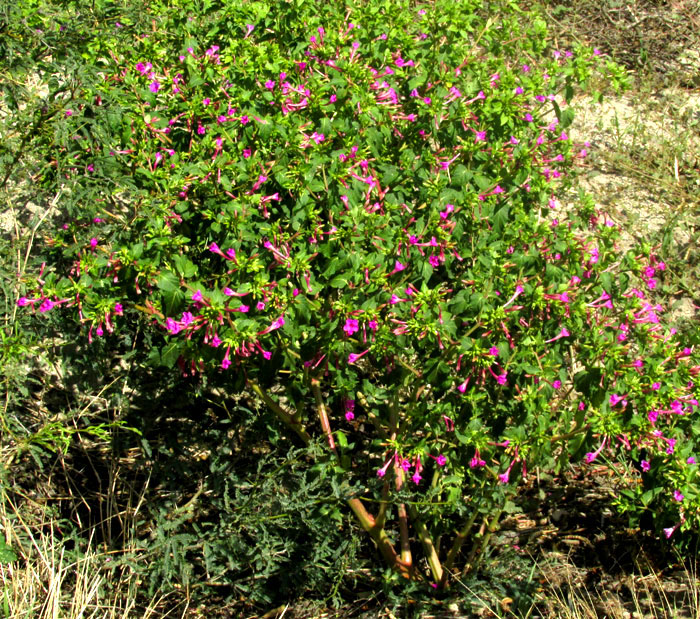
In this semi-arid area if you're on a sunny little country road on a level valley floor where the soil is deep, and there's a modest, weedy-bottomed drainage ditch along the way, chances are that the above perennial herb will be present. Sometimes, in fact, this plant forms almost pure stands for long stretches of ditch. You might recognize it as the favorite old-time garden ornamental known as Four O'Clock, sometimes called the Marvel of Peru, MIRABILIS JALAPA.
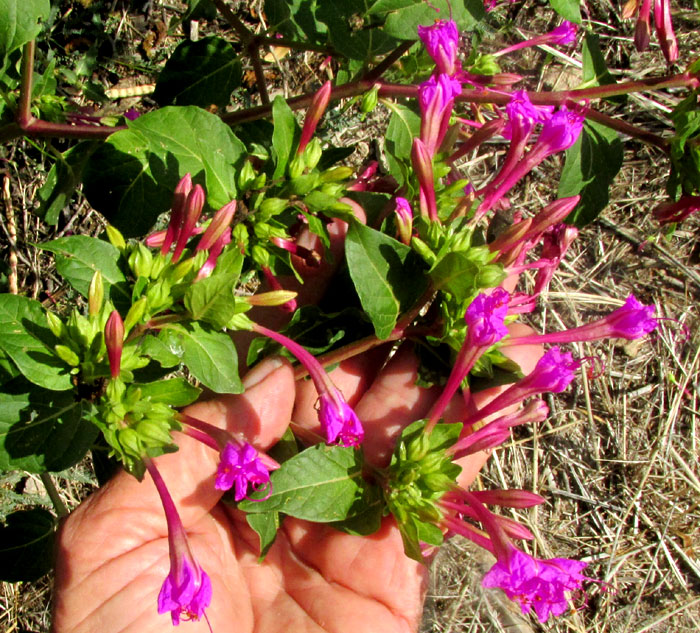
Four-O'Clocks get their name from their blossoms opening late in the day. At night they're pollinated by sphinx moths and other nocturnal pollinators with long tongue-like proboscises, then in early morning the corollas droop and remain hanging on the plant awhile. At 10 o'clock one morning our plant's flowers were starting to go limp, the only fresh-looking ones being those in the shade, shown above.
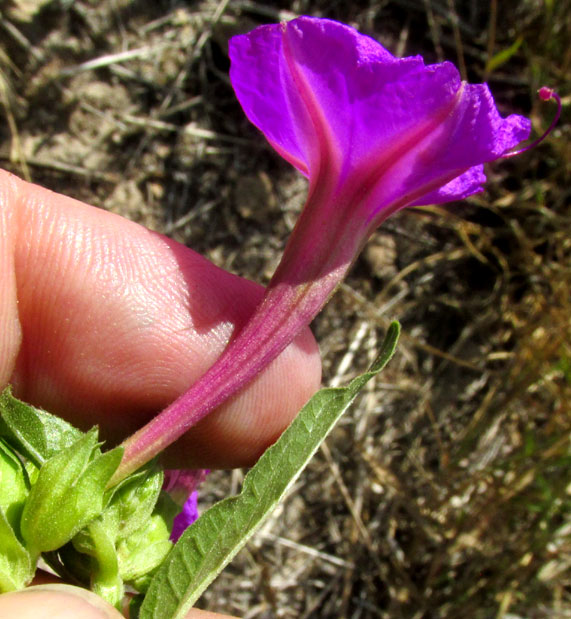
Above you can see how long the corolla's tube is relative to its spreading' top part. Nectar resides at the very bottom of the tube, so the pollinator is encouraged to come close, to daub itself with the flower's orangish-yellow pollen, issued from splitting-open, reddish anthers at the tip of the stamens' long, curling, purple filaments, shown below:
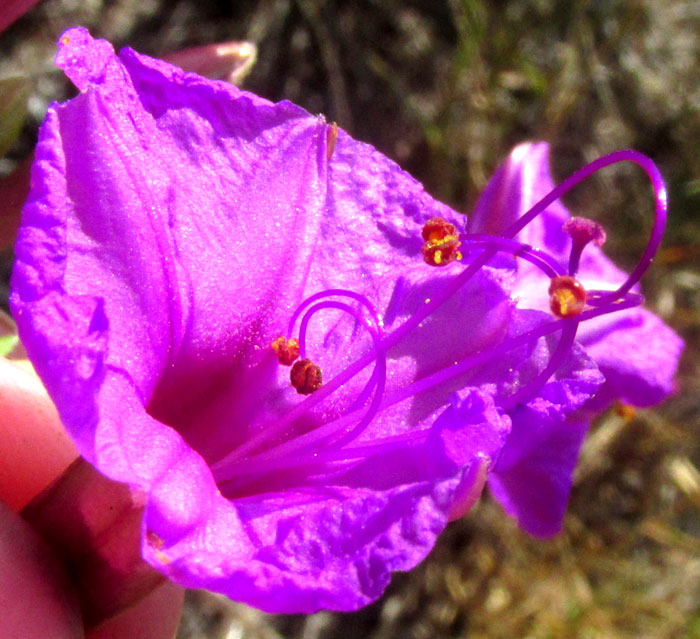
Note that the pollen grains are unusually large, which is a special feature of the Four-O'Clock Family, the Nyctaginaceae. Maybe big pollen grains are harder to blow off the forehead of a sphinx moth with its whirring wings.
Here's our plant's leaf, arising on the stem opposite another leaf just like itself:
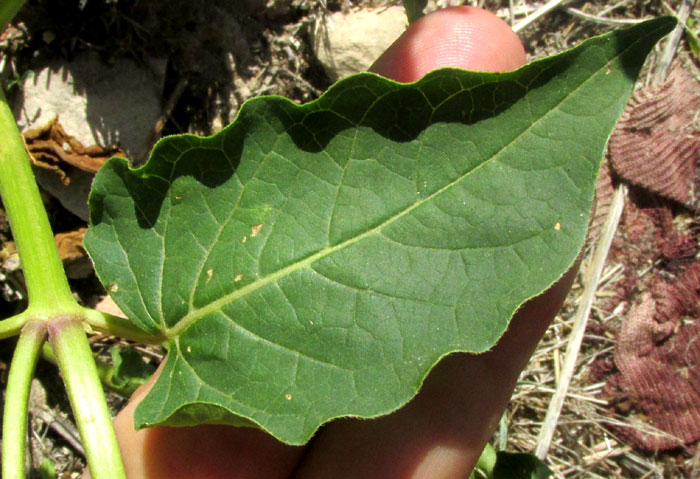
The stems are much branched, thick and succulent looking, but somewhat weak and brittle, breaking easily if roughly handled.
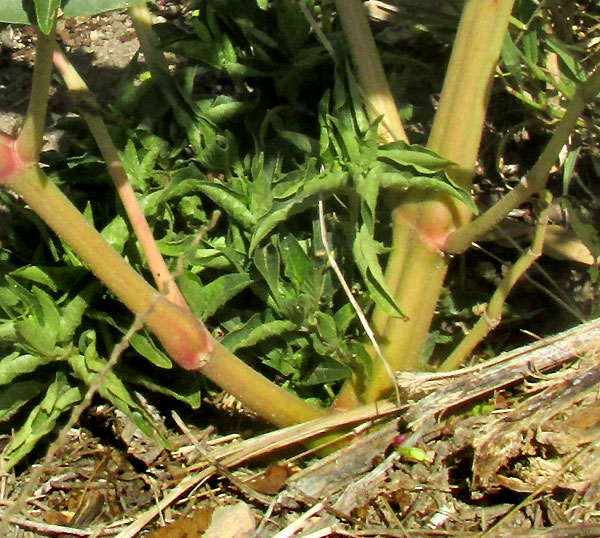
The stems arise from a dark, swollen, carrot-shaped root. Surely the thick stems and enlarged rootstock account for how such a tender-looking plant manages to thrive in our droughty landscape. During rare showers it must store water, then slowly parcel the water out during long rainless times.
The Flora del Bajío says that probably this species flowers in our area year round, but mostly around the end of the rainy season.
Despite this species' prettiness and abundant presence, I've been avoiding documenting it because it's so common both as a worldwide garden plant and a weed throughout the tropics everywhere. However, finally it dawned on me that here the species has special status. In the plant's binomial, Mirabilis jalapa -- Linnaeus himself named it in 1753 -- the jalapa is the old spelling for the town of Xalapa, here in Mexico, just over the Eastern Sierra Madres from us, in the state of Veracruz. This weed is native Mexican.
Four O'Clocks are known to contain powerful chemical compounds, and they have a rich history of use by early Mexicans. Rafael Enrique Fonseca Chávez's online Guía Ilustrada de Plantas Medicinales den el Valle de México mentions our plant's use against various kinds of inflammations, including pimples, and epileptic seizures, to reduce tumor size, for stomach ache, sore throat, various cuts and scratches, varicose veins, kidney problems, fever, Huntington disease and more.
Moreover, as Linnaeus's naming the plant in 1753 indicates, our plant has been known in many parts of the world for a long time and is used traditionally there, too. In traditional Chinese medicine, where it's known as 紫茉莉, meaning Mirabilis, its roots are used to induce urine flow, purge heat, and activate blood. Flowers are used to moisten the lungs and cool blood. Some cultures regard the large root as aphrodisiacal.
However, the Chinese also know that it's toxic, and can cause an inflamed and sore mouth, vomiting, diarrhea, headache, dizziness, tinnitus and hearing loss. On the Internet, pet web pages warn that the roots and seeds are highly toxic for dogs and cats. In fact, all parts of our plants should be considered poisonous if ingested.
So, medicine or poison? It all depends on how you use it. In the US, the indigenous Acoma and Laguna Pueblo tribes traditionally dried the leaves for smoking, which reportedly had a sedative effect. In fact, our plant's tender young leaves have been cooked and eaten with no problems, but it's advised to do so only when nothing else is available.